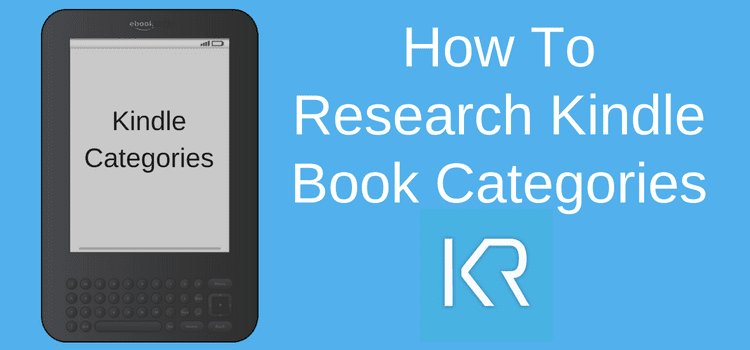
Every author wants to publish an Amazon bestseller. But do you know how to choose Amazon book categories as part of book marketing?
Sure, you have your Author Central page, and you promote your book on social media.
You might even understand keyword requirements and know about choosing Kindle search keywords.
But in learning how to sell on Amazon, you also need to know all about how to add book categories on Amazon.
How to check Amazon book categories
To see the list of main categories, go to Amazon. Click on the Kindle Store> Kindle ebooks, and you will see a list down the left-hand side.
There are millions of Kindle ebooks in the Kindle Store.
So if you want to sell more books, you need to be very selective about your two Kindle ebook categories for your type of book.
You should avoid putting your Amazon book in broad and highly competitive categories.
It will be difficult for your book to appear high enough to be seen by book buyers.
In these over-populated broad browse Kindle categories, it is next to impossible to get your book in the top 100 books.
If you list your books in a category such as Romance or Fiction>Fantasy, you will have no chance of readers finding your book.
Header categories such as this have thousands upon thousands of books. So your chances of appearing in search results or being found by a category browsing reader are next to zero.
You really want to help your sales rank and your book sales.
So you have to do your research to find the absolute best two categories for your book on Amazon Kindle.
But how do you do your research for a specific Amazon book category?
There is never a guarantee that your book will achieve bestselling book status.
However, being selective and choosing the best specific category you can find will help.
Then you need to do it again for your second.
Fortunately, help is at hand in learning how to choose Amazon book categories.
Alex from Kindle Ranker has kindly written a detailed explanation about how to go about your category research.
He started Kindle Ranker as a free service to help authors answer simple questions like; which category best fits my book?
Today, Kindle Ranker tracks 10,000 categories and more than 200,000 Amazon bestsellers to help you navigate through Amazon’s esoteric ranking system.
Here is what Alex has to say about how to choose Amazon book categories.
How to promote a book about science fiction – The basics first!
First of all, why should you really care about promotion?
If you are in the middle of writing your first sci-fi novel, you might hastily close down this tab.
Then sip your coffee (or scotch, no judgment) and daydream about the success you will spontaneously achieve once you publish your excellent novel.
After all, you are a writer. Your job is to write. If the writing is good, people will eventually come?
I’m sure you wish it were as simple as that.
Amazon and most other outlets, for that matter, reward a bestselling author … not best-writing authors, mind you, bestselling authors!
Writing a good book is only half the job. The second – and oh so important – half is promoting said book so that every potential reader gets the chance and opportunity to discover your work.
Because let’s face it, if you do not promote your book, nobody will.
Make no mistake, though. I am not here to talk about classic book promotion tips.
Social media ads, content marketing, and similar techniques that get thrown around are a dime a dozen in every other blog.
I intend on tackling a much more fundamental aspect of publishing a book: choosing the right category to maximize your profit on Kindle.
Amazon has over 168 additional categories or subcategories dedicated to science fiction alone.
If you choose the wrong subcategory, you could end up competing against George R.R. Martin or Isaac Asimov. Your chances of making any income are slim at best.
See, the first page of the bestseller list only accommodates 50 books.
If your book does not make it to the top 50 in its category, it will not spontaneously appear to readers browsing categories on Amazon.
The equation that follows is, therefore, very straightforward.
No views equal no sales, and no sales mean no royalties. We do not want that situation at all. So let’s get started with this very important question.
What is the least competitive category in Science Fiction?
Before we delve into the good stuff, please bear in mind that all the data presented here is but a snapshot in time.
The exact numbers likely changed between the time I started this article and the time I submitted it for publication.
The trend, however, remains constant, and more importantly, the thought process is the same.
You can fully replicate this analysis with up-to-date metrics using the specialized search engine on Kindle Ranker.
A very crude definition of competitiveness can be solely derived from the number of daily sales.
If we outnumber the 50th book in a given category, we will make it to the front page of the category’s bestseller list.
From then on, the increased visibility will likely generate organic sales that will help push our book even further up the list.
It seems reasonable enough, so what does the data say?
To make it more manageable and easier to digest in an article, I removed Teen and Children’s Science Fiction categories.
Also, audiobooks, which still gives us around 78 subcategories to explore in science fiction.
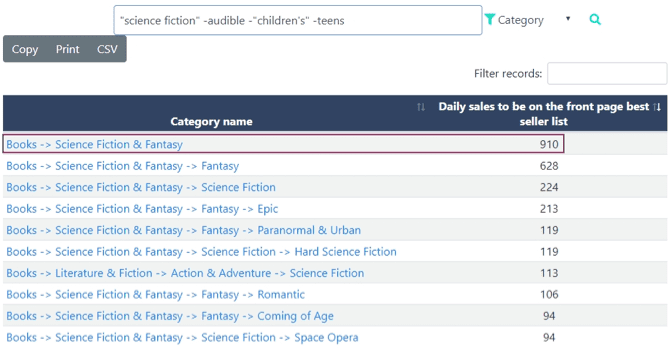
If you were thinking of randomly choosing your science fiction subcategory, I hope these first numbers made you reconsider.
Selling 910 copies a day to barely make it to the front page bestseller list of the Fantasy subcategory is no easy task. Especially for an unknown writer launching their first novel.
So let’s put this first result aside and continue exploring other subcategories down the list. Thankfully, we quickly find gentler and kinder alternatives:
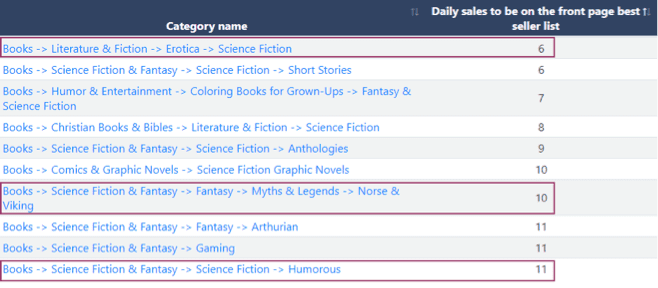
Much better, right? Selling 6-10 books a day may require a few nudges.
But that is something one can achieve with the help of the right tools.
These are keywords in the title and description, putting out ads, content marketing, book promotion, and so forth.
To sum up, then, possible subcategories that one could consider for a new or existing novel are :
Norse & Viking
Erotica
LGBT
Short stories
Humorous
Steampunk
As you can see, this accessibility comes at a steep price that you should take into account: specialization.
It would not be fair to readers to publish an Arthurian Novel in the Norse & Viking subcategory on the sole basis of a lower best-seller threshold.
You should try to stay faithful to your genre and theme lest you disappoint a number of readers.
That being said, I find that most fiction books are rich enough to accommodate many genres, so this should not be an issue. e.g: The story is heavily based on a northern myth. But the main character, a lesbian, turned werewolf, evolved in a steampunk or contemporary city, and so on … That’s at least 5 subcategories right there!
This first list of 15-20 accessible categories set us on the right path, but we do not have the full story covered yet.
The second key promotion variable is readers’ interest
We identified a dozen categories that exhibit a low bestseller threshold, but how to narrow it down to the two or three most promising categories?
How can we determine if a category is promising? Or, to state it differently, how can we measure readers’ interest in a given subject or category?
Amazon does not gladly share this data.
But we can try to infer such an elusive quantity by calculating the median royalties generated by books in the top 20 of each category.
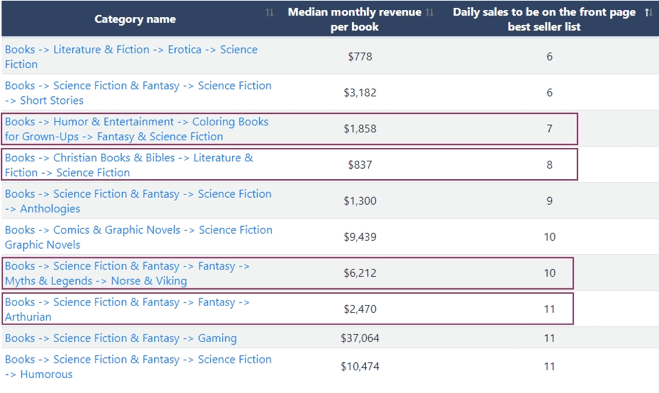
We clearly see that while the threshold sales for the “Christian Books & Bible” and “Coloring books for grown-ups” are similar. But the payout is vastly different!
So if we have a book that can fit into both categories, we would be better off choosing the latter one.
Similarly, for the “Norse & Viking” and “Arthurian” subcategories.
The same promotion efforts will spill out much more payout in the “Norse & Viking” subcategory since the potential revenue is much higher.
Let’s look at the top of the median revenue list to tickle our imagination a bit:

We can follow the same logic once again.
Why waste precious dollars on promoting a book in the “Space Opera” category with its high threshold? The “Dystopian” category promises equivalent potential with a much lower sales threshold.
Before you drift off to paradise city, where the pay is green, and the sales are pretty, please allow me to stress one important fact.
The median revenue shown above is just that…a hypothetical median! Some authors/publishers will make less, while others will make more.
Moreover, it only applies to books that remain in the top 20 for a month.
A feat that is quite rare in itself since books move from one position to another almost hourly.
This makes it difficult to hit the numbers shown above. So take this median revenue for what it really is. It’s an indicator of readers’ interest, no more.
That being said, notice the “Dungeons & Dragons” category.
You can practically just enroll your book and be on the front page bestseller list. On top of that, the payout is great.
The gaming category is actually on fire right now. Check out the number of releases during the last three months:

100% of the top 20 in each of these categories were released during the last three months. Sadly there is very little indie presence in these categories :

A total of 16 out of 20 categories exhibit 0% indie best sellers.
There is clearly room for some original contributions there, especially since the daily sales thresholds are very low (1 to 2 sales per day).
The categories where indie writers shine the most are listed below:
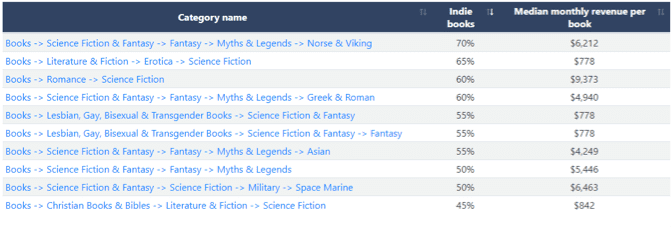
The order varies widely from one hour to the next, but the category names are pretty much constant: Erotica, Romance, Myths & Legends, etc.
It is always interesting to keep the median book revenue in sight as it puts everything in perspective.
Why waste time on a category with little reader interest when other categories (perhaps equally or less competitive) are available?
Now what?
Now you are a pro at how to choose Amazon book categories.
You know how to focus your marketing efforts on the most promising categories (that fit your book, of course).
All the data presented above is available at Kindle Ranker should you want to replicate the results or search for your own niche.
Update: Amazon has made significant changes to the process of selecting Amazon KDP categories for books and ebooks.
Related Reading: Amazon Search Results For Books Guide For New KDP Authors


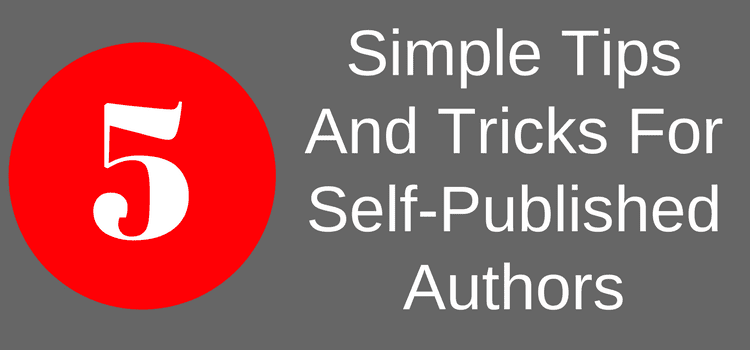
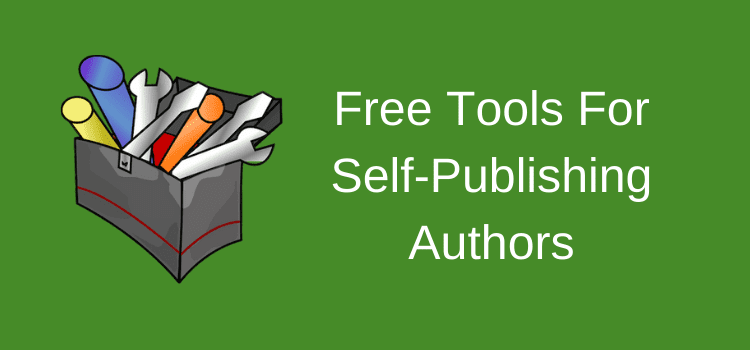
I am not clear
Where on Amazon will I find a way to categorize my books?
Derek –
Your point about the indie presence in gaming materials is intriguing, but are you considering that these publications are going to be through traditional publishers, because of the intellectual property rights involved?
I couldn’t just write and publish an indie Battletech novel – I’d get sued.
If you see a way around that, I’d be interested in hearing it.
Daniel
It’s an interesting point, Daniel. The article concentrates on category selection. But as for legal issues regarding content, that’s a whole different ball game.
Thank you so much for writing this article! This is a gold mine of information!
Gosh! Really excellent advice. Thank you. Now I’m off to try AGAIN at marketing my book!
Very clear and basic thank you so much